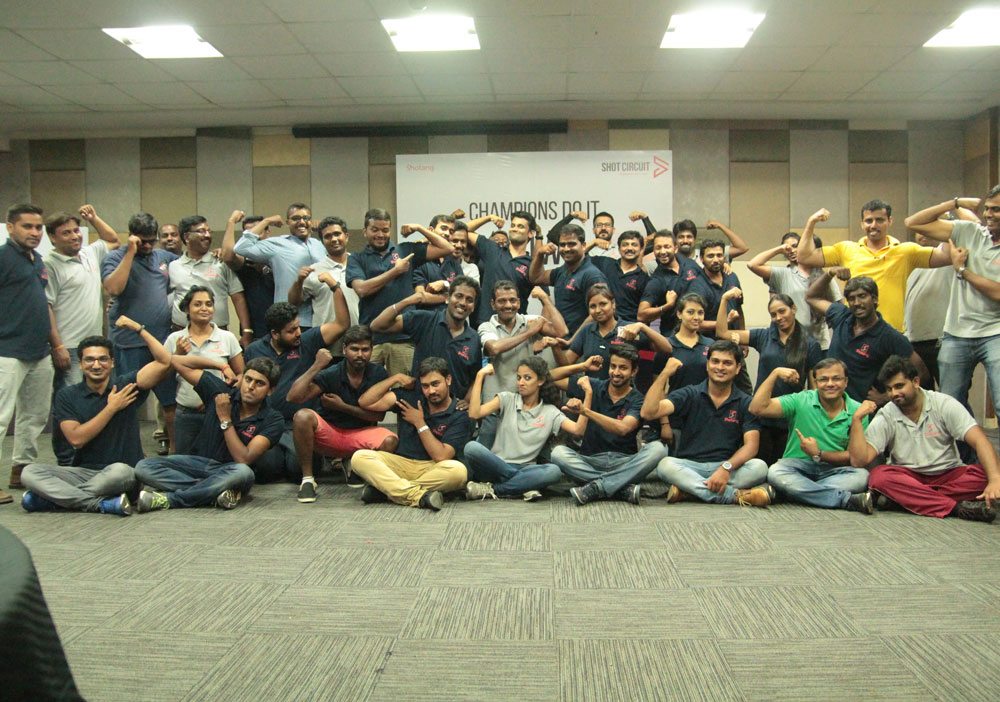Shotang addresses the retail industry’s need for a solution to better manage their supply chain through its mobile app.
Retailing and trading is perhaps one of the oldest professions in our country. Retail distribution contributes to nearly 25 per cent of India’s GDP at $630 billion, has around 15 million retail establishments and indirectly employs close to about 12 per cent of the country’s population. The industry has grown at a CAGR of around 6-8 per cent in the last 15 years.
However, Anish Basu Roy, Co-Founder & CEO, Shotang, found that processes in the traditional distribution channel are manually intensive, high cost and lead to massive information asymmetry.
The founding team, which includes Anterpreet Singh – Co founder & President, and Vishal BG – COO, comes with over three decades of expertise in the retail distribution industry having worked in companies such as Coca-Cola, Nokia, and Britannia. “During the course of our professional careers, we worked with the traditional retail distribution channel across the country and were aware of the inefficiencies that exist in this ecosystem,” says Basu. Therefore, the three started Shotang with the vision of tech-transforming the traditional distribution channel with an on-cloud platform. “We always believed that technology could solve all the three problems faced by the industry,” he explains.
Shotang Solution
Shotang was started in 2015 $300,000 in a seed round from Bitchemy Ventures, and $5 million raised from Exfinity Ventures and Unitus Impact in 2015.
Right from the outset the company decided to focus on solving a massive, complex India-specific problem that would require a unique business model, processes, user interfaces and technology solutions keeping in mind the needs of the traditional retailers and suppliers. “We did not have any global precedent to replicate,” he points out.
Shotang developed a mobile app which the retailer to order inventory across all the brands that he resells from his store. The orders are processed by the most price competitive suppliers (wholesalers, distributors and manufacturers) in that city and kept ready for dispatch.
Shotang’s logistics operation using our in-house logistics tool, Falcon, ships these products in a single consignment to the retailer within 24 hours. Payments are collected using our digital payment platforms or utilizing the credit offered by NBFCs on the basis of transactions vintage of the retailer on Shotang. “In the last two years, we have emerged as the leading retail distribution platform in India and are well on our way to completely tech-transform the traditional retail distribution market,” Basu explains.

Challenges and Opportunities
Since retailers were not very technology savvy, Shotang designed the product to be simple and easy to use. As a result, the company has over 15000 retailers effortlessly ordering thousands of products, making payments and availing credit on the platform on a 4/5-inch screen of their smartphone. Shotang has grown their GMV rates by almost 43 times in the last one year and have gone from less than 500 retailers to almost 15,000 as of date across seven cities.
The deep subject matter expertise the founders had in the retail distribution space also enabled them to build the technology and business processes keeping in mind existing business rules and transactions between the traditional retailer and supplier. “This helps them adopt our platform with tremendous ease and get the best user experience,” explains Basu.
Shotang has also forged strong partnerships with several brands, digital lenders and payment platforms, making their business highly scalable. Basu also gives his team due credit, mentioning the unique cultural fabric with a deep focus on customer experience and commitment that have enabled it to meet its goals. “We constantly work towards improving our organization culture and have a written-down document which embodies this called The Champions’ Code 4.0,” he adds.
To the Market
Targeted marketing and extracting ROI from all marketing investments is deeply built-in to Shotang’s philosophy. And so, the company does not use mass media for user acquisition but largely relies on targeted product marketing and direct marketing initiatives.
“We are innovating heavily in this area since it involves bringing on board users who may not even be online. Most of the retailers on our platform are not very digitally savvy and Shotang is pretty much the only business app they use,” he explains. That is also one of the key reasons why the marketing is highly targeted and personalized, keeping in mind the user profile.
New features are constantly added onto the platform based on functionality. Product features such as Multi-Tier Pricing helps the retailer maximize his margins by buying more in every order. “We have recently launched a feature called Watchlist which helps the retailer remain on top of price changes and inventory availability on the platform real-time,” explains Basu.
During the course of our professional careers, we worked with the traditional retail distribution channel across the country and were aware of the inefficiencies that exist in this ecosystem.
Benefiting the Ecosystem
One of the benefits of the Shotang solution is that it can empower traditional retailers procure their inventory at better margins and higher operational convenience. Their working capital efficiencies is enhanced by enabling access to credit from banks/NBFCs and cutting-edge payment solutions such as UPI. Retailers can also get higher access to brands through the platform.
Manufacturers (sellers) benefit by selling to retailers directly on the Shotang platform because of the rapid market access, lower cost of sales and distribution and better access to sales/inventory data. The channel helps brands save cost without having to build distribution infrastructure themselves.
“The biggest difference between all our other competitors and us is that we are a platform, which helps the brand and retailer transact directly through suppliers who hold inventory in the channel. All our competitors are stock-and-sell and hold their own inventory,” explains Basu. Shotang leverages on the capabilities that existing stakeholders such as payment platforms and digital lending companies offer, without necessarily building them in-house.
Shotang has a deep focus on warehousing and logistics capabilities, which is a critical component of the retailer’s experience. “We offer 24-hour delivery timelines and reverse logistics capabilities which are unique to us,” he adds.
Basu believes that their technology is another major differentiator as all retailer and supplier interfaces, workflows and business rules are designed keeping in mind the way business gets transacted offline. “This helps our users migrate easily to our tech platform with minimum dissonance,” he opines.
Disrupting the Business
“Not only do we hope to transform businesses for the 15 million retailers in India and improve livelihoods for the people working in this industry – we hope to have an impact on the growth rate of the industry itself,” Basu shares his vision. For this, the company is building in data, insights and analytics that will help improve fill rates, inventory and working capital efficiencies significantly.
“Given our deep focus on financial prudence and process control, we perfected our model in just two cities over a period of 6-9 months before expanding into three more,” explains he. The company first stabilised operations in the three new markets and tested the iterative model for 3-6 months before getting into two more cities. “In a business which is transactions intensive, we believe process control is as important as growth. This is our mantra for building a business with a long-term focus,” says Basu.
Currently Shotang helps more than 15,000 retailers and over 200 suppliers across seven cities and has team of 320 employees. The aim is to increase its presence across the top 100 cities. From mobile and handset accessories space, which is where it is present currently, it wants to expand its reach to enable the stakeholders of retail distribution across four to six categories with a target market size of over $80 billion. Targeted marketing, relevant supply chain management features, logistics and warehouse support, and continued focus on processes will drive its growth.
Automating Retail Distribution
Traditional distribution channels are manually intensive, high cost and lead to massive information asymmetry. The founding team, which includes Anish Basu Roy, Co-Founder & CEO, Anterpreet Singh – Co founder & President, and Vishal BG – COO, comes with over three decades of expertise in the retail distribution industry having worked in companies such as Coca-Cola, Nokia, and Britannia. Having worked with the traditional retail distribution channel across the country, they were aware of the inefficiencies that existed in this ecosystem. Therefore, the three started Shotang with the vision of tech-transforming the traditional distribution channel with an on-cloud platform. The company received $300,000 in a seed round when it started in 2015 from Bitchemy Ventures, and $5 million from Exfinity Ventures and Unitus Impact in 2015. Currently Shotang helps more than 15,000 retailers and over 200 suppliers across seven cities and has team of 320 employees. It plans to increase its presence across the top 100 cities, expand the reach from mobile and handset accessories space to another four to six categories with a target market size of over $80 billion. Targeted marketing, relevant supply chain management features, logistics and warehouse support, and continued focus on processes will drive its growth.
